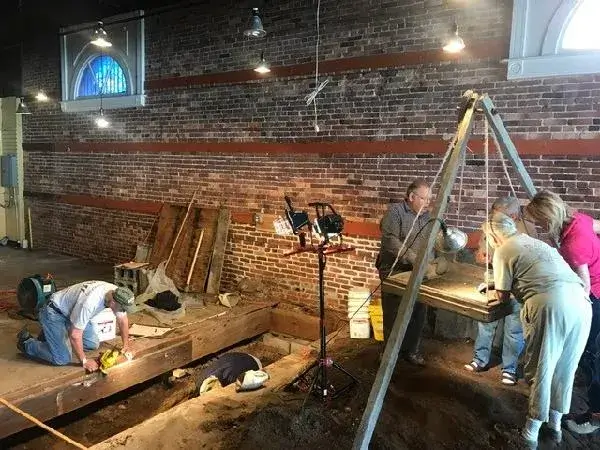
Skeletons Found Under A Florida Wine Shop May Be Some of America’s First Colonists
The skeletons, found in St. Augustine, Florida, likely date to the first decades of the oldest European settlement in the United States.
By: Jason Daley | Smithsonian
In the last few weeks, archaeologists digging under the floor of a wine shop in St. Augustine, Florida, have discovered the skeletal remains of seven people, including three children, believed to be some of the earliest colonists in North America, report Jessica Clark and Melissa Guz at FirstCoast News.
According to FirstCoast, last October hurricane Matthew damaged a wine shop on St. Augustine’s plaza. After the hurricane, building owner David White decided to renovate the space. According to a press release from the city, the floor of the building was built on a joist system constructed in 1888, which left the soil below relatively intact. White offered the city archaeologist Carl Hibert a chance to take a peek under the floor before the repairs began.
Hibert accepted the offer, but did not have high hopes of finding anything. He was wrong—after just a few shovelfuls of dirt, he found human remains.
During the first week of digging in February, archaeologists first discovered an intact adult skeleton and an adult skull nearby. According to Susan Parker at The St. Augustine Register, the bodies have been preliminarily identified as a relatively young white European woman and a man of African ancestry. Outside of the wine shop, they found a leg bone and another skull from two other graves. Last week, they discovered the remains of the children.
Special Forces ATTACKED by Unidentified Creature | The Kandahar Giant
Though the remains have not been fully analysed, a bio-archaeologist believes the children were all under 7 years old. All of the human remains were found in a 6-by-12-foot area, reports Clark.
Pottery fragments found with the skeletons date the burials between 1572 and 1586, a few years after St. Augustine, known as America’s oldest city, was founded.
There are indications that there may be other remains in the same area.
The History Blog reports that Hibert believes the burials may come from the floor of the Church of Nuestra Señora de la Remedios, the parish church built in St. Augustine soon after the colony was established by conquistador Pedro Menendez de Aviles in 1565, 42 years before the Jamestown Colony was established by the English and 55 years before the Pilgrims arrived in Massachusetts.
The church was burned down in a raid by British privateer Sir Francis Drake in 1586. The rebuilt church burned again during a hurricane in 1599 and was destroyed for good when the British torched the structure in 1702.
The exact location of the church, however, was not discovered until 2010, reports Marcia Lane at St. Augustine.com. During construction on Aviles Street in the city’s historic downtown, Halbirt discovered a trench and a wall that marked the rear of the church. The digging also uncovered some human bones that the researcher believes may have been the bodies of priests.
It’s believed that the footprint of the church extended all the way to the present day wine shop, and the bodies were likely buried under the church floor, a standard practice for Catholics at the time. “The mission churches across Florida buried everybody in the church floor,” Ellsbeth “Buff” Gordon, an architectural historian, tells Clark and Guz. “It was consecrated ground, of course.”
“What you’re dealing with is people who made St. Augustine what it is,” Halbirt tells Clark and Guz. “You’re in total awe. You want to treat everything with respect and we are.”
The skeletons found inside the wine shop will remain where they are, though the bones collected from outside the shop will be removed to a nearby Catholic cemetery to make way for a city water line.
* * *
NEXT UP!
Five Canoes Discovered Northwest of Rome Are The Oldest Boats Ever Found In The Mediterranean
For more than 30 years, one of Italy’s most well-hidden archaeological treasures has been an underwater village called La Marmotta.
The site, with well-preserved artefacts, was discovered in 1989 in a lake just northwest of Rome and 23 miles upstream from the Mediterranean Sea. Found among its wooden buildings were five canoes, stretching up to 32 feet long and made from hollowed-out trees. Estimated to be 7,000 years old, the boats showed signs of being equipped with advanced maritime technology, including towing accessories and reinforcements.
Because the original discovery of La Marmotta had only ever been published in the Italian language, widespread study of the canoes and their place in history remained limited. But now that a team of international researchers revisited the site and published their findings in English in the journal PLOS One, scientists around the world are learning about the boats for the first time—and the bustling, sophisticated Mediterranean trade they suggest.
* * *
READ MORE: Antediluvian Period: What Was The World Like Before The Flood
Interesting! 20 Unexplainable Mysteries That Will Blow Your Mind
Telegram: Stay connected and get the latest updates by following us on Telegram!
We’d love to hear from you! If you have a comment about this article or if you have a tip for a future Collective Spark Story please let us know below in the comment section.
